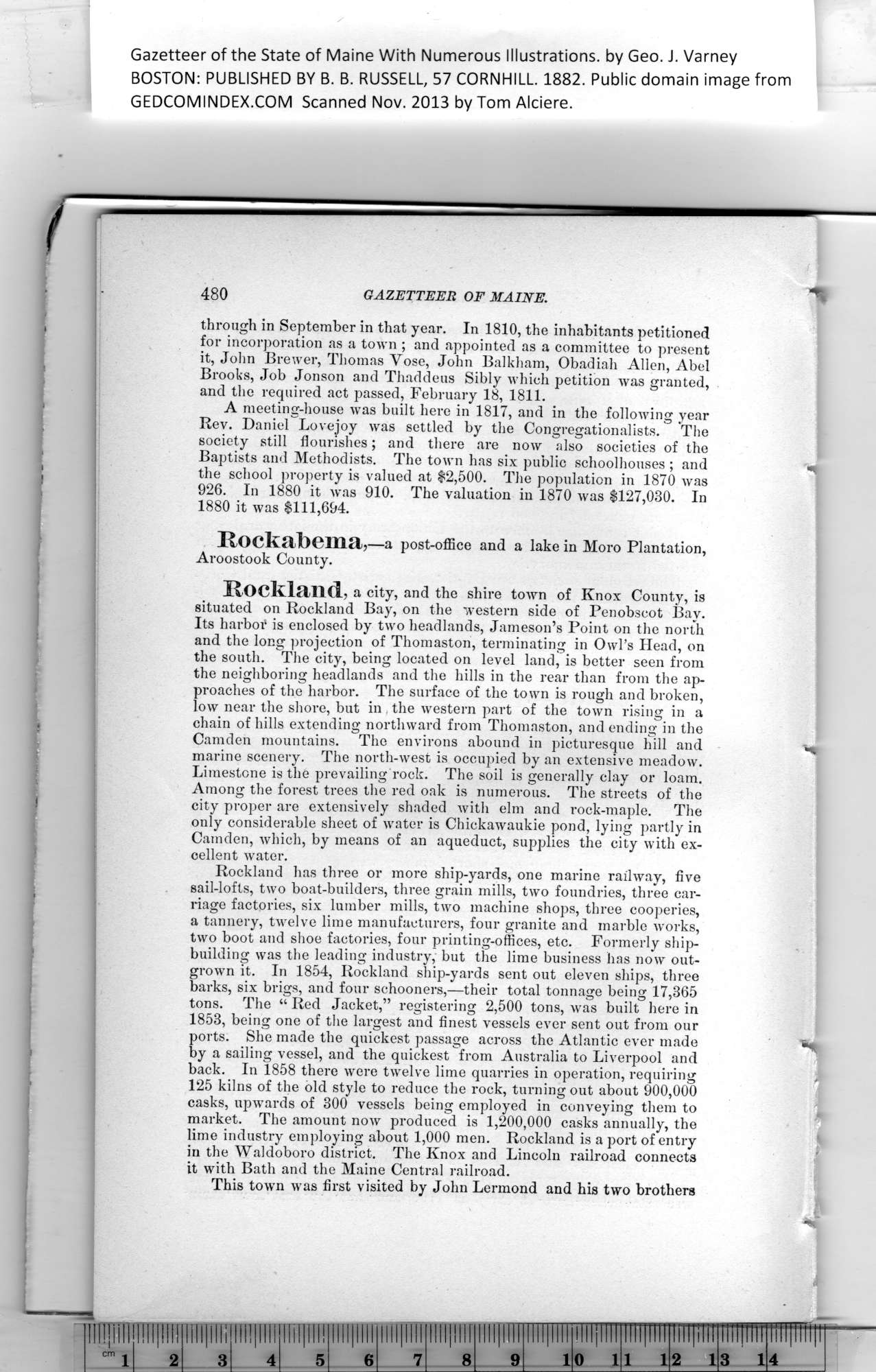|
Gazetteer of the State of Maine With Numerous Illustrations, by Geo. J. Varney
BOSTON: PUBLISHED BY B. B. RUSSELL, 57 CORNHILL. 1882. Public domain image from
f -
! 480 GAZETTEER OF MAINE.
through in September in that year. In 1810, the inhabitants petitioned
for incorporation as a town ; and appointed as a committee to present
it, John Brewer, Thomas Vose, John Balkham, Obadiah Alien, Abel
Brooks, Job Jonson and Thaddens Sibly which petition was granted,
and the required act passed, February 18, 1811.
A meeting-house was built here in 1817, and in the following year
Rev. Daniel Lovejoy was settled by the Congregationalists. The
society still flourishes; and there are now also societies of the
Baptists and Methodists. The town has six public schoolhouses ; and
the school property is valued at $2,500. The population in 1870 was
926. In 1880 it was 910. The valuation in 1870 was $127,030. In
1880 it was $111,694.
Hockabema,—a post-office and a lake in Moro Plantation,
Aroostook County.
Rockland, a city, and the shire town of Knox County, is
situated on Rockland Bay, on the western side of Penobscot Bay.
Its harbor is enclosed by two headlands, Jameson’s Point on the north
and the long projection of Thomaston, terminating in Owl’s Head, on
the south. The city, being located on level land, is better seen from
the neighboring headlands and the hills in the rear than from the ap-
proaches of the harbor. The surface of the town is rough and broken,
low near the shore, but in the western part of the town rising in a
chain of hills extending northward from Thomaston, and ending in the
Camden mountains. The environs abound in picturesque hill and
marine scenery. The north-west is occupied by an extensive meadow.
Limestone is the prevailing rock. The soil is generally clay or loam.
Among the forest trees the red oak is numerous. The streets of the
I city proper are extensively shaded with elm and rock-maple. The
only considerable sheet of water is Chickawaukie pond, lying partly in
Camden, which, by means of an aqueduct, supplies the city with ex-
cellent water.
Rockland has three or more ship-yards, one marine railway, five
sail-lofts, two boat-builders, three grain mills, two foundries, three car-
riage factories, six lumber mills, two machine shops, three cooperies,
a tannery, twelve lime manufacturers, four granite and marble works,
two boot and shoe factories, four printing-offices, etc. Formerly ship-
1 building was the leading industry, but the lime business has now out-
grown it. In 1854, Rockland ship-yards sent out eleven ships, three
barks, six brigs, and four schooners,—their total tonnage being 17,365
tons. The “ Red Jacket,” registering 2,500 tons, was built here in
1853, being one of the largest and finest vessels ever sent out from our
ports. She made the quickest passage across the Atlantic ever made
by a sailing vessel, and the quickest from Australia to Liverpool and
back. In 1858 there were twelve lime quarries in operation, requiring
125 kilns of the old style to reduce the rock, turning out about 900,000
casks, upwards of 300 vessels being employed in conveying them to
market. The amount now produced is 1,200,000 casks annually, the
lime industry employing about 1,000 men. Rockland is a port of entry
in the Waldoboro district. The Knox and Lincoln railroad connects
it with Bath and the Maine Central railroad.
This towrn was first visited by John Lermond and his two brothers
PREVIOUS PAGE ... NEXT PAGE
This page was written in HTML using a program written in Python 3.2
|
